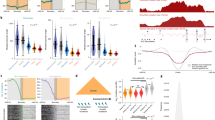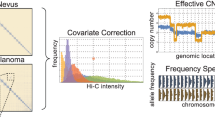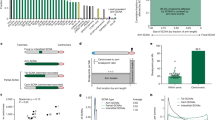Abstract
The accumulation of data on structural variation in cancer genomes provides an opportunity to better understand the mechanisms of genomic alterations and the forces of selection that act upon these alterations in cancer. Here we test evidence supporting the influence of two major forces, spatial chromosome structure and purifying (or negative) selection, on the landscape of somatic copy-number alterations (SCNAs) in cancer1. Using a maximum likelihood approach, we compare SCNA maps and three-dimensional genome architecture as determined by genome-wide chromosome conformation capture (HiC) and described by the proposed fractal-globule model2,3. This analysis suggests that the distribution of chromosomal alterations in cancer is spatially related to three-dimensional genomic architecture and that purifying selection, as well as positive selection, influences SCNAs during somatic evolution of cancer cells.
This is a preview of subscription content, access via your institution
Access options
Subscribe to this journal
Receive 12 print issues and online access
$209.00 per year
only $17.42 per issue
Buy this article
- Purchase on Springer Link
- Instant access to full article PDF
Prices may be subject to local taxes which are calculated during checkout




Similar content being viewed by others
References
Beroukhim, R. et al. The landscape of somatic copy-number alteration across human cancers. Nature 463, 899–905 (2010).
Lieberman-Aiden, E. et al. Comprehensive mapping of long-range interactions reveals folding principles of the human genome. Science 326, 289–293 (2009).
Mirny, L.A. The fractal globule as a model of chromatin architecture in the cell. Chromosome Res. 19, 37–51 (2011).
Greenman, C. et al. Patterns of somatic mutation in human cancer genomes. Nature 446, 153–158 (2007).
Wood, L.D. et al. The genomic landscapes of human breast and colorectal cancers. Science 318, 1108–1113 (2007).
Beroukhim, R. et al. Assessing the significance of chromosomal aberrations in cancer: methodology and application to glioma. Proc. Natl. Acad. Sci. USA 104, 20007–20012 (2007).
The Cancer Genome Atlas Research Network. Comprehensive genomic characterization defines human glioblastoma genes and core pathways. Nature 455, 1061–1068 (2008).
Berger, M.F. et al. The genomic complexity of primary human prostate cancer. Nature 470, 214–220 (2011).
Wijchers, P.J. & de Laat, W. Genome organization influences partner selection for chromosomal rearrangements. Trends Genet. 27, 63–71 (2011).
Meaburn, K.J., Misteli, T. & Soutoglou, E. Spatial genome organization in the formation of chromosomal translocations. Semin. Cancer Biol. 17, 80–90 (2007).
Nikiforova, M.N. et al. Proximity of chromosomal loci that participate in radiation-induced rearrangements in human cells. Science 290, 138–141 (2000).
Branco, M.R. & Pombo, A. Intermingling of chromosome territories in interphase suggests role in translocations and transcription-dependent associations. PLoS Biol. 4, e138 (2006).
Grosberg, A.Y., Nechaev, S.K. & Shakhnovich, E.I. The role of topological constraints in the kinetics of collapse of macromolecules. J. Phys. 49, 2095–2100 (1988).
Nowell, P.C. The clonal evolution of tumor cell populations. Science 194, 23–28 (1976).
Merlo, L.M., Pepper, J.W., Reid, B.J. & Maley, C.C. Cancer as an evolutionary and ecological process. Nat. Rev. Cancer 6, 924–935 (2006).
Lee, W. et al. The mutation spectrum revealed by paired genome sequences from a lung cancer patient. Nature 465, 473–477 (2010).
Hastings, P.J., Lupski, J.R., Rosenberg, S.M. & Ira, G. Mechanisms of change in gene copy number. Nat. Rev. Genet. 10, 551–564 (2009).
Armitage, P., Berry, G. & Matthews, J.N.S. Statistical Methods in Medical Research (Blackwell Science, Malden, MA, 2001).
Hastings, P.J., Bull, H.J., Klump, J.R. & Rosenberg, S.M. Adaptive amplification: an inducible chromosomal instability mechanism. Cell 103, 723–731 (2000).
Moran, P.A.P. The Statistical Processes of Evolutionary Theory (Clarendon Press, Oxford, 1962).
Chiarle, R. et al. Genome-wide translocation sequencing reveals mechanisms of chromosome breaks and rearrangements in B cells. Cell 147, 107–119 (2011).
Klein, I.A. et al. Translocation-capture sequencing reveals the extent and nature of chromosomal rearrangements in B lymphocytes. Cell 147, 95–106 (2011).
Mayer, R. et al. Common themes and cell type specific variations of higher order chromatin arrangements in the mouse. BMC Cell Biol. 6, 44 (2005).
Roix, J.J., McQueen, P.G., Munson, P.J., Parada, L.A. & Misteli, T. Spatial proximity of translocation-prone gene loci in human lymphomas. Nat. Genet. 34, 287–291 (2003).
Stratton, M.R., Campbell, P.J. & Futreal, P.A. The cancer genome. Nature 458, 719–724 (2009).
Haber, D.A. & Settleman, J. Cancer: drivers and passengers. Nature 446, 145–146 (2007).
Schwarz, G. Estimating the dimension of a model. Ann. Stat. 6, 461–464 (1978).
Acknowledgements
We thank members of the Mirny Lab for helpful conversations, in particular with C. McFarland regarding purifying selection and M. Imakaev regarding fractal globules. We thank C. Mermel for an introduction to SCNA data. We thank V. Agarwala, J. Engrietz, R. McCord and J. Dekker for helpful comments and suggestions. This work was supported by the US National Institutes of Health/National Cancer Institute Physical Sciences Oncology Center at MIT (U54CA143874). G.G. and M.M. are TCGA-funded investigators (NIH U24CA143845, U24CA144025 and U24CA143867).
Author information
Authors and Affiliations
Contributions
G.F. designed the study, performed data analysis and wrote the paper; G.G. and M.M. provided expertise in SCNA analysis and developed the manuscript; L.A.M. designed the study, performed initial data analysis and wrote the paper.
Corresponding author
Ethics declarations
Competing interests
The authors declare no competing financial interests.
Supplementary information
Supplementary Text and Figures
Supplementary Figures 1–9 and Supplementary Table 1 (PDF 1161 kb)
Rights and permissions
About this article
Cite this article
Fudenberg, G., Getz, G., Meyerson, M. et al. High order chromatin architecture shapes the landscape of chromosomal alterations in cancer. Nat Biotechnol 29, 1109–1113 (2011). https://doi.org/10.1038/nbt.2049
Received:
Accepted:
Published:
Issue Date:
DOI: https://doi.org/10.1038/nbt.2049
This article is cited by
-
Three-dimensional genome landscape comprehensively reveals patterns of spatial gene regulation in papillary and anaplastic thyroid cancers: a study using representative cell lines for each cancer type
Cellular & Molecular Biology Letters (2023)
-
Rewiring of the 3D genome during acquisition of carboplatin resistance in a triple-negative breast cancer patient-derived xenograft
Scientific Reports (2023)
-
Integrative Identification by Hi-C Revealed Distinct Advanced Structural Variations in Lung Adenocarcinoma Tissue
Phenomics (2023)
-
Chemically Induced Chromosomal Interaction (CICI) method to study chromosome dynamics and its biological roles
Nature Communications (2022)
-
High-resolution single-cell 3D-models of chromatin ensembles during Drosophila embryogenesis
Nature Communications (2021)



